Two-Dimensional Transthoracic Echocardiography-Based Diagnosis of Right Ventricular Aneurysm: A Neglected Issue in Patients with Coronary Artery Disease: Case Series and Literature Review
Abstract
1. Introduction
2. Case Presentation
3. Discussion
4. Conclusions
Supplementary Materials
Author Contributions
Funding
Institutional Review Board Statement
Informed Consent Statement
Data Availability Statement
Acknowledgments
Conflicts of Interest
References
- Roth, G.A.; Abate, D.; Abate, K.H.; Abay, S.M.; Abbafati, C.; Abbasi, N.; Abbastabar, H.; Abd-Allah, F.; Abdela, J.; Abdelalim, A. Global, regional, and national age-sex-specific mortality for 282 causes of death in 195 countries and territories, 1980–2017: A systematic analysis for the Global Burden of Disease Study 2017. Lancet 2018, 392, 1736–1788. [Google Scholar] [CrossRef]
- Bowry, A.D.; Lewey, J.; Dugani, S.B.; Choudhry, N.K. The burden of cardiovascular disease in low-and middle-income countries: Epidemiology and management. Can. J. Cardiol. 2015, 31, 1151–1159. [Google Scholar] [CrossRef]
- Ye, Q.; Zhang, J.; Ma, L. Predictors of all-cause 1-year mortality in myocardial infarction patients. Medicine 2020, 99, e21288. [Google Scholar] [CrossRef]
- Bajaj, A.; Sethi, A.; Rathor, P.; Suppogu, N.; Sethi, A. Acute complications of myocardial infarction in the current era: Diagnosis and management. J. Investig. Med. 2015, 63, 844–855. [Google Scholar] [CrossRef] [PubMed]
- Sharma, A.; Kumar, S. Overview of left ventricular outpouchings on cardiac magnetic resonance imaging. Cardiovasc. Diagn. Ther. 2015, 5, 464–470. [Google Scholar] [PubMed]
- Vallabhajosyula, S.; Kanwar, S.; Aung, H.; Cheungpasitporn, W.; Raphael, C.E.; Gulati, R.; Singh, M. Temporal trends and outcomes of left ventricular aneurysm after acute myocardial infarction. Am. J. Cardiol. 2020, 133, 32–38. [Google Scholar] [CrossRef]
- Kalisz, K.; Rajiah, P. Radiological features of uncommon aneurysms of the cardiovascular system. World J. Radiol. 2016, 8, 434–438. [Google Scholar] [CrossRef]
- Umapathi, K.K.; Bokowski, J.W.; Nguyen, H.H. Congenital right ventricular aneurysm with characteristics of a pseudoaneurysm. Cardiol. Young 2020, 30, 732–733. [Google Scholar] [CrossRef]
- Duong, P.; Annavarapu, S.; Moran, P.; McBrien, A. Fetal right ventricular aneurysm caused by chronic progressive myocardial ischemia. Ultrasound Obstet. Gynecol. 2017, 50, 540–541. [Google Scholar] [CrossRef]
- Shakil, O.; Josephson, M.E.; Matyal, R.; Khabbaz, K.R.; Mahmood, F. Traumatic right ventricular aneurysm and ventricular tachycardia. Heart Rhythm. 2012, 9, 1501–1503. [Google Scholar] [CrossRef] [PubMed]
- Finocchiaro, G.; Murphy, D.; Pavlovic, A.; Haddad, F.; Shiran, H.; Sinagra, G.; Ashley, E.A.; Knowles, J.W. Unexplained double-chambered left ventricle associated with contracting right ventricular aneurysm and right atrial enlargement. Echocardiography 2014, 31, E80–E84. [Google Scholar] [CrossRef]
- Teixeira Filho, G.; Schvartzmann, P.; Kersten, R. Right ventricular aneurysm following right ventricular infarction. Heart 2004, 90, 472. [Google Scholar] [CrossRef] [PubMed]
- Ortoleva, J.; Ohlrich, K.; Kawabori, M. A Rapid Development of a Right Ventricular Aneurysm Postmyocardial Infarction. J. Cardiothorac. Vasc. Anesth. 2020, 34, 1377–1379. [Google Scholar] [CrossRef] [PubMed]
- Akdemir, O.; Gül, Ç.; Özbay, G. Right ventricular aneurysm complicating right ventricular infarction. Acta Cardiol. 2001, 56, 261–262. [Google Scholar] [CrossRef]
- Andersen, H.R.; Falk, E. Isolated right ventricular aneurysm following right ventricular infarction. Cardiology 1987, 74, 479–482. [Google Scholar] [CrossRef] [PubMed]
- Zhang, Z.; Tendulkar, A.; Sun, K.; Saloner, D.A.; Wallace, A.W.; Ge, L.; Guccione, J.M.; Ratcliffe, M.B. Comparison of the Young-Laplace law and finite element based calculation of ventricular wall stress: Implications for postinfarct and surgical ventricular remodeling. Ann. Thorac. Surg. 2011, 91, 150–156. [Google Scholar] [CrossRef]
- Ghadimi, K. Right Ventricular Aneurysmal Formation: The Right (La) Place at the Right Time. J. Cardiothorac. Vasc. Anesth. 2020, 34, 1380–1381. [Google Scholar] [CrossRef] [PubMed]
- Klein, L.R.; Shroff, G.R.; Beeman, W.; Smith, S.W. Electrocardiographic criteria to differentiate acute anterior ST-elevation myocardial infarction from left ventricular aneurysm. Am. J. Emerg. Med. 2015, 33, 786–790. [Google Scholar] [CrossRef]
- Hirose, K.; Amiya, E.; Ishizuka, M.; Uehara, M.; Komuro, I. Progressive Right Ventricular Aneurysm in a Patient with Systemic Sarcoidosis. J. Cardiovasc. Imaging 2019, 27, 158–161. [Google Scholar] [CrossRef]
- Dedeilias, P.; Kouerinis, I.; Apostolakis, E.; Bellenis, I. A rare case of a large right ventricular aneurysm. Eur. J. Cardiothorac. Surg. 2004, 25, 644. [Google Scholar] [CrossRef]
- Voter, A.F.; Kanne, J.P.; Kuner, A.D.; Gettle, L.M. Incidental discovery of a rare right ventricular aneurysm. Radiol. Case Rep. 2021, 16, 704–706. [Google Scholar] [CrossRef] [PubMed]
- Incalzi, R.A.; Capparella, O.; Gemma, A.; Puglielli, L.; Bonetti, M.G.; Carbonin, P. Right ventricular aneurysm: A new prognostic indicator after a first acute myocardial infarction. Cardiology 1991, 79, 120–126. [Google Scholar] [CrossRef]
- Frustaci, A.; Chimenti, C.; Natale, L. Right ventricular aneurysm associated with advanced hypertrophic cardiomyopathy. Chest 1998, 113, 552–554. [Google Scholar] [CrossRef] [PubMed]
- Vandenberg, R.; Donnelly, G.L.; Macleod, K.; Monk, I. Aneurysm of the right ventricle caused by selective angiocardiography. Circulation 1964, 30, 902–906. [Google Scholar] [CrossRef]
- Inoue, S.-I.; Murakami, Y.; Shimada, T.; Inoue, A.; Maruyama, R. Right ventricular aneurysm caused by acute myocarditis. Can. J. Cardiol. 2000, 16, 1025–1028. [Google Scholar] [PubMed]
- Lull, R.J.; Dunn, B.E.; Gregoratos, G.; Cox, W.A.; Fisher, G.W. Ventricular aneurysm due to cardiac sarcoidosis with surgical cure of refractory ventricular tachycardia. Am. J. Cardiol. 1972, 30, 282–287. [Google Scholar] [CrossRef]
- Sakaguchi, T.; Akagi, S.; Totsugawa, T.; Tamura, K.; Hiraoka, A. Right ventricular pseudoaneurysm. Eur. Heart J. Cardiovasc. Imaging 2018, 19, 823. [Google Scholar] [CrossRef] [PubMed]
- Cua, C.L.; Sanghavi, D.; Voss, S.; Laussen, P.C.; del Nido, P.; Marshall, A.; Breitbart, R.E. Right ventricular pseudoaneurysm after modified Norwood procedure. Ann. Thorac. Surg. 2004, 78, e72–e73. [Google Scholar] [CrossRef] [PubMed]
- Feng, Y.; Wang, Q.; Chen, G.; Ye, D.; Xu, W. Impaired renal function and abnormal level of ferritin are independent risk factors of left ventricular aneurysm after acute myocardial infarction: A hospital-based case–control study. Medicine 2018, 97, e12109. [Google Scholar] [CrossRef] [PubMed]
- Cai, Q.; K Mukku, V.; Ahmad, M. Coronary artery disease in patients with chronic kidney disease: A clinical update. Curr. Cardiol. Rev. 2013, 9, 331–339. [Google Scholar] [CrossRef]
- Vallianou, N.G.; Mitesh, S.; Gkogkou, A.; Geladari, E. Chronic kidney disease and cardiovascular disease: Is there any relationship? Curr. Cardiol. Rev. 2019, 15, 55–63. [Google Scholar] [CrossRef]
- Jensen, C.J.; Jochims, M.; Hunold, P.; Sabin, G.V.; Schlosser, T.; Bruder, O. Right ventricular involvement in acute left ventricular myocardial infarction: Prognostic implications of MRI findings. Am. J. Roentgenol. 2010, 194, 592–598. [Google Scholar] [CrossRef]
- Kalliath, S.; Nair, R.G.; Vellani, H. Endomyocardial fibrosis with right ventricular aneurysm mimicking ARVC–A case report from India. Indian Heart J. 2016, 68, S93–S96. [Google Scholar] [CrossRef] [PubMed]
- Kodikara, S. A death following hemopericardium due to rupture of a right ventricular aneurysm due to a congenital ventricular septal defect. J. Forensic Sci. 2013, 58, S258–S260. [Google Scholar] [CrossRef] [PubMed]
- Wolf, D.A.; Burke, A.P.; Patterson, K.V.; Virmani, R. Sudden death following rupture of a right ventricular aneurysm 9 months after ablation therapy of the right ventricular outflow tract. Pacing Clin. Electrophysiol. 2002, 25, 1135–1137. [Google Scholar] [CrossRef] [PubMed]
- Kakouros, N.; Cokkinos, D.V. Right ventricular myocardial infarction: Pathophysiology, diagnosis, and management. Postgrad. Med. J. 2010, 86, 719–728. [Google Scholar] [CrossRef] [PubMed]
- Pinamonti, B.; Brun, F.; Mestroni, L.; Sinagra, G. Arrhythmogenic right ventricular cardiomyopathy: From genetics to diagnostic and therapeutic challenges. World J. Cardiol. 2014, 6, 1234–1244. [Google Scholar] [CrossRef]
- Sattar, Y.; Alraies, M.C. Ventricular Aneurysm; StatPearls Publishing: Treasure Island, FL, USA, 2021. Available online: https://www.ncbi.nlm.nih.gov/books/NBK555955/ (accessed on 10 April 2023).
- Delewi, R.; Zijlstra, F.; Piek, J.J. Left ventricular thrombus formation after acute myocardial infarction. Heart 2012, 98, 1743–1749. [Google Scholar] [CrossRef] [PubMed]
- Murphy, J.G.; Wright, R.S.; Barsness, G.W. Ischemic left ventricular aneurysm and anticoagulation: Is it the clot or the plot that needs thinning? Mayo Clin. Proc. 2015, 90, 428–431. [Google Scholar] [CrossRef]
 Anterior wall of the RV: supplied by acute marginal branches.
Anterior wall of the RV: supplied by acute marginal branches.  Lateral wall of the RV: supplied by acute marginal branches.
Lateral wall of the RV: supplied by acute marginal branches.  Anterior wall of the RVOT: supplied by conus branch.
Anterior wall of the RVOT: supplied by conus branch.  Inferior wall of the RV: supplied by the posterior descending artery. Abbreviations: A5C: apical five chamber; A4C: apical four chamber; AO: aorta; AV: aortic valve; LA: left atrium; LV: left ventricle; PLAX: parasternal long axis view (illustrating RVOT); PSAX: parasternal short axis view; RA: right atrium; RV: right ventricle; Subcostal 4C view: subcostal four chamber view. (A). Parasternal long axis view. (B). Parasternal Short axis view. (C). Parasternal RV inflow view. (D). Parasternal short axis view of great vessels. (E). Apical four chamber view. (F). Apical four chamber- RV focus view. (G). Apical five chamber view. (H). Parasternal right ventricular modified view. (I). Subcostal four chamber/long axis view.
Inferior wall of the RV: supplied by the posterior descending artery. Abbreviations: A5C: apical five chamber; A4C: apical four chamber; AO: aorta; AV: aortic valve; LA: left atrium; LV: left ventricle; PLAX: parasternal long axis view (illustrating RVOT); PSAX: parasternal short axis view; RA: right atrium; RV: right ventricle; Subcostal 4C view: subcostal four chamber view. (A). Parasternal long axis view. (B). Parasternal Short axis view. (C). Parasternal RV inflow view. (D). Parasternal short axis view of great vessels. (E). Apical four chamber view. (F). Apical four chamber- RV focus view. (G). Apical five chamber view. (H). Parasternal right ventricular modified view. (I). Subcostal four chamber/long axis view.
 Anterior wall of the RV: supplied by acute marginal branches.
Anterior wall of the RV: supplied by acute marginal branches.  Lateral wall of the RV: supplied by acute marginal branches.
Lateral wall of the RV: supplied by acute marginal branches.  Anterior wall of the RVOT: supplied by conus branch.
Anterior wall of the RVOT: supplied by conus branch.  Inferior wall of the RV: supplied by the posterior descending artery. Abbreviations: A5C: apical five chamber; A4C: apical four chamber; AO: aorta; AV: aortic valve; LA: left atrium; LV: left ventricle; PLAX: parasternal long axis view (illustrating RVOT); PSAX: parasternal short axis view; RA: right atrium; RV: right ventricle; Subcostal 4C view: subcostal four chamber view. (A). Parasternal long axis view. (B). Parasternal Short axis view. (C). Parasternal RV inflow view. (D). Parasternal short axis view of great vessels. (E). Apical four chamber view. (F). Apical four chamber- RV focus view. (G). Apical five chamber view. (H). Parasternal right ventricular modified view. (I). Subcostal four chamber/long axis view.
Inferior wall of the RV: supplied by the posterior descending artery. Abbreviations: A5C: apical five chamber; A4C: apical four chamber; AO: aorta; AV: aortic valve; LA: left atrium; LV: left ventricle; PLAX: parasternal long axis view (illustrating RVOT); PSAX: parasternal short axis view; RA: right atrium; RV: right ventricle; Subcostal 4C view: subcostal four chamber view. (A). Parasternal long axis view. (B). Parasternal Short axis view. (C). Parasternal RV inflow view. (D). Parasternal short axis view of great vessels. (E). Apical four chamber view. (F). Apical four chamber- RV focus view. (G). Apical five chamber view. (H). Parasternal right ventricular modified view. (I). Subcostal four chamber/long axis view.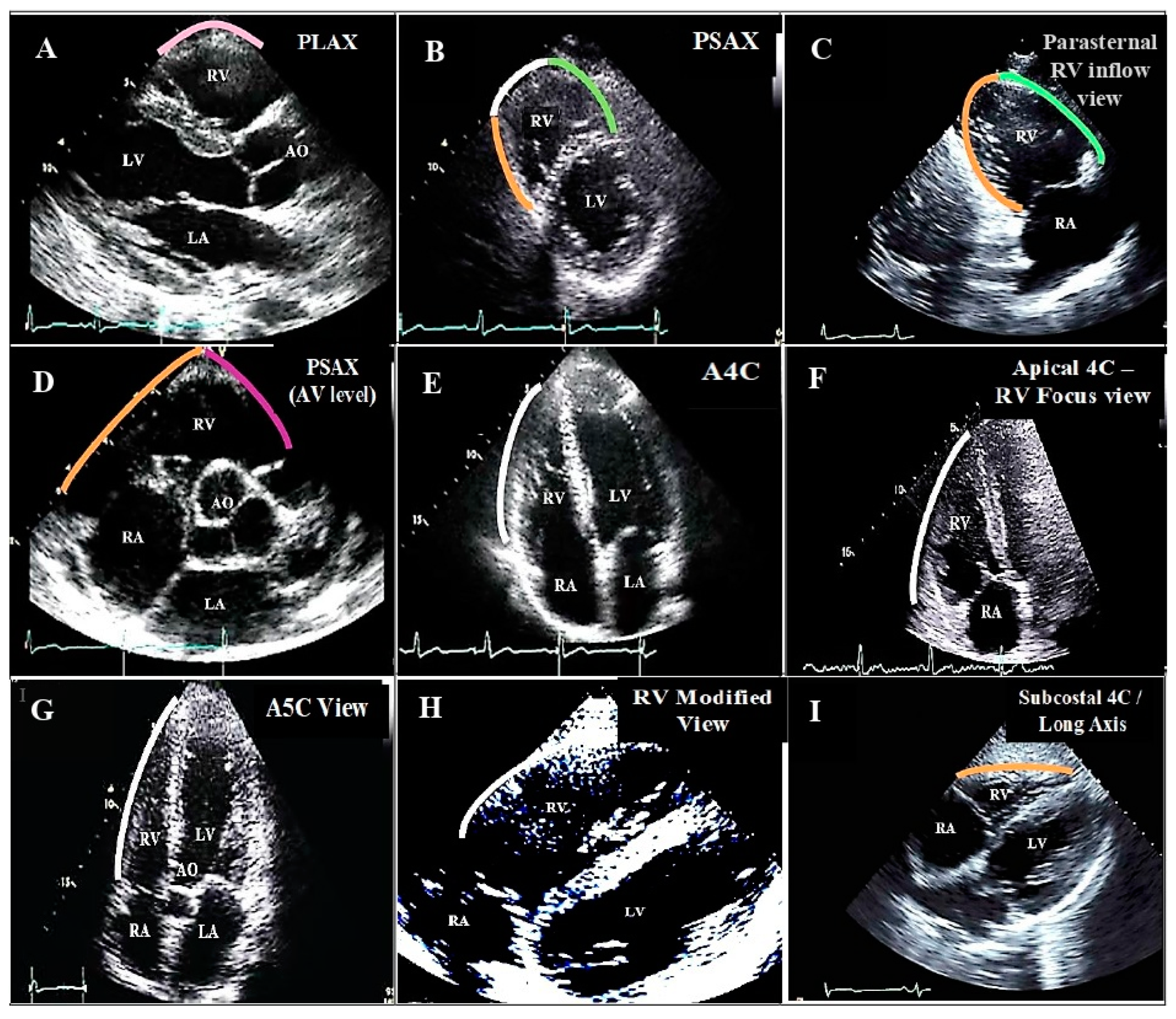
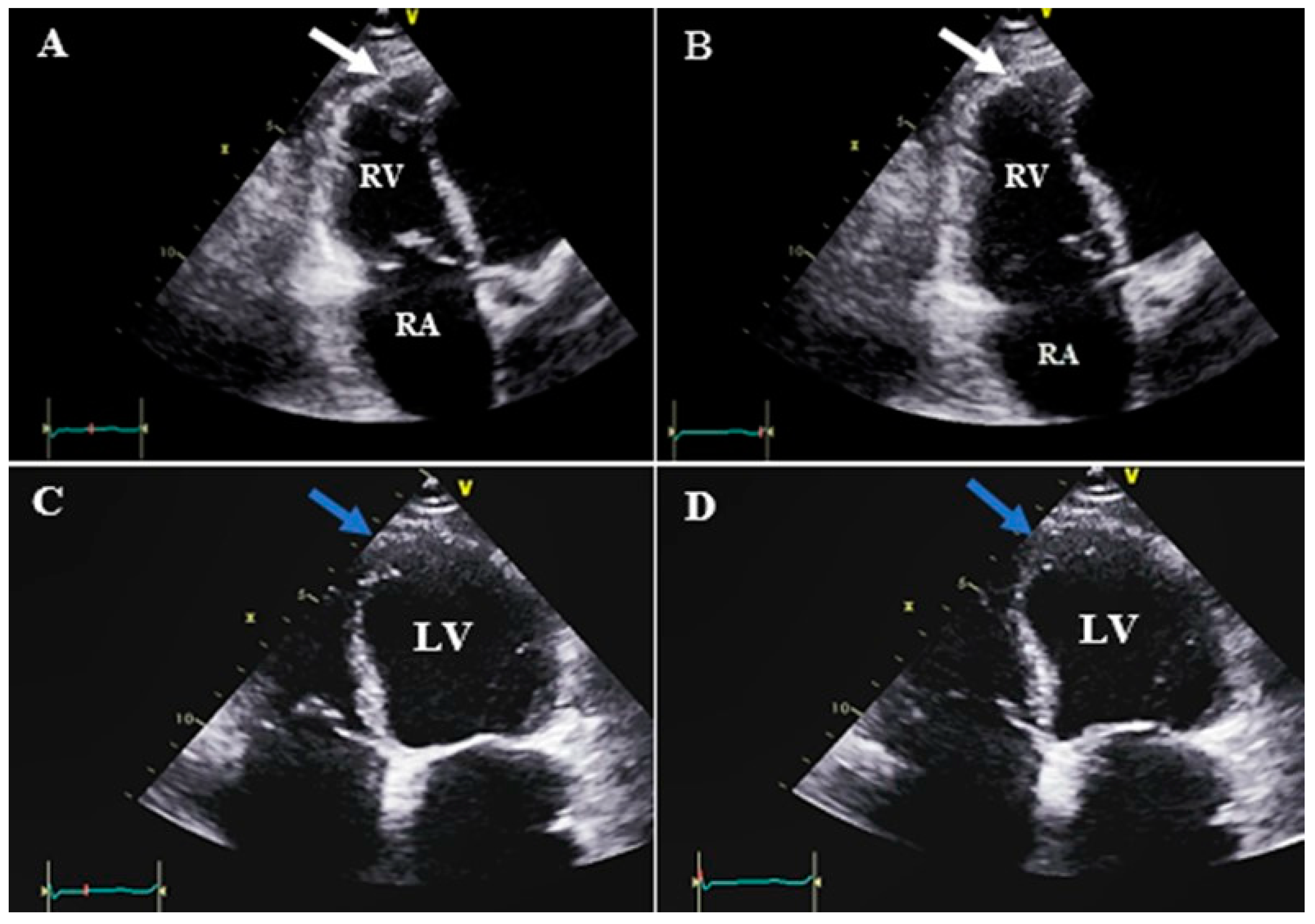
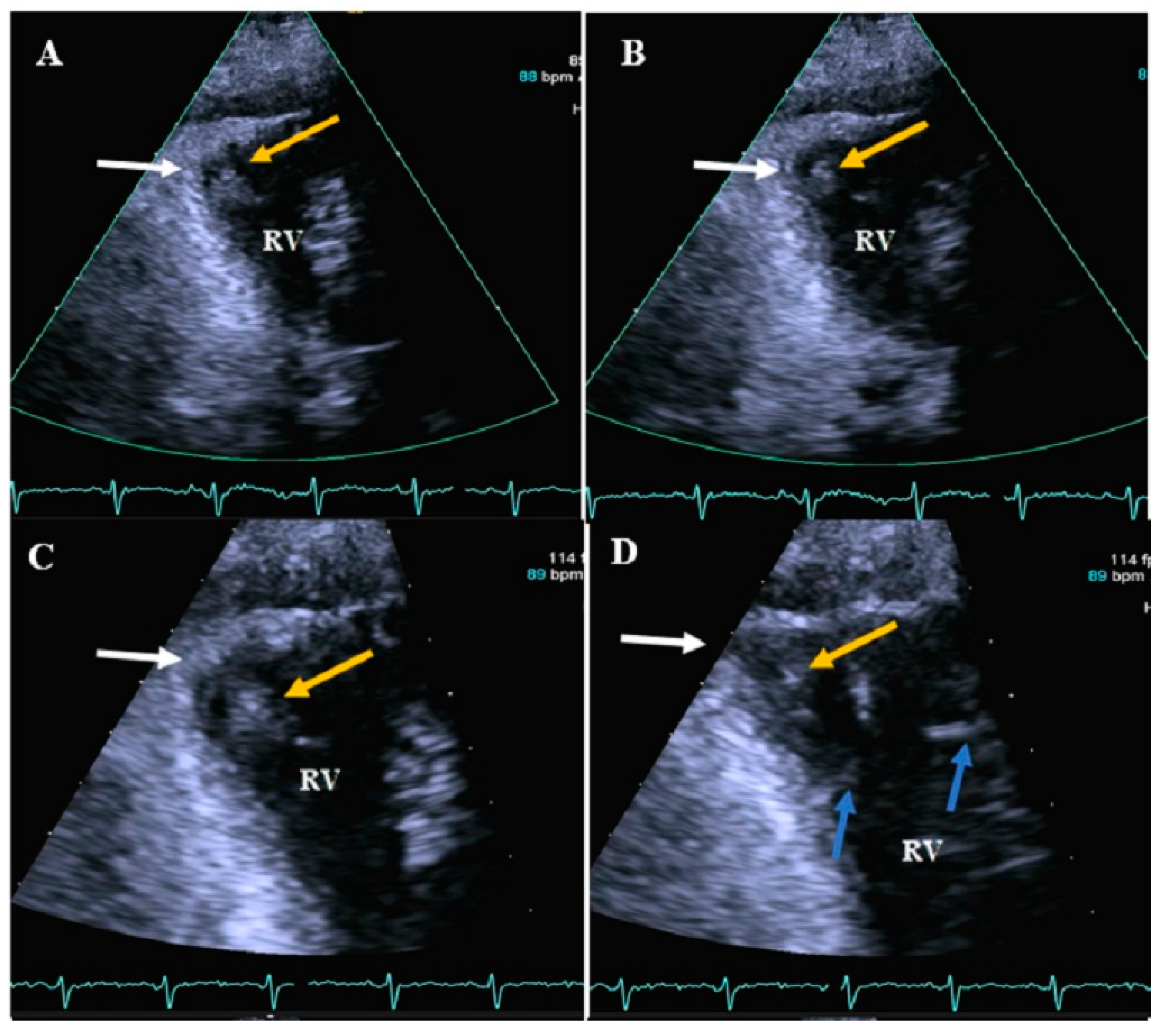
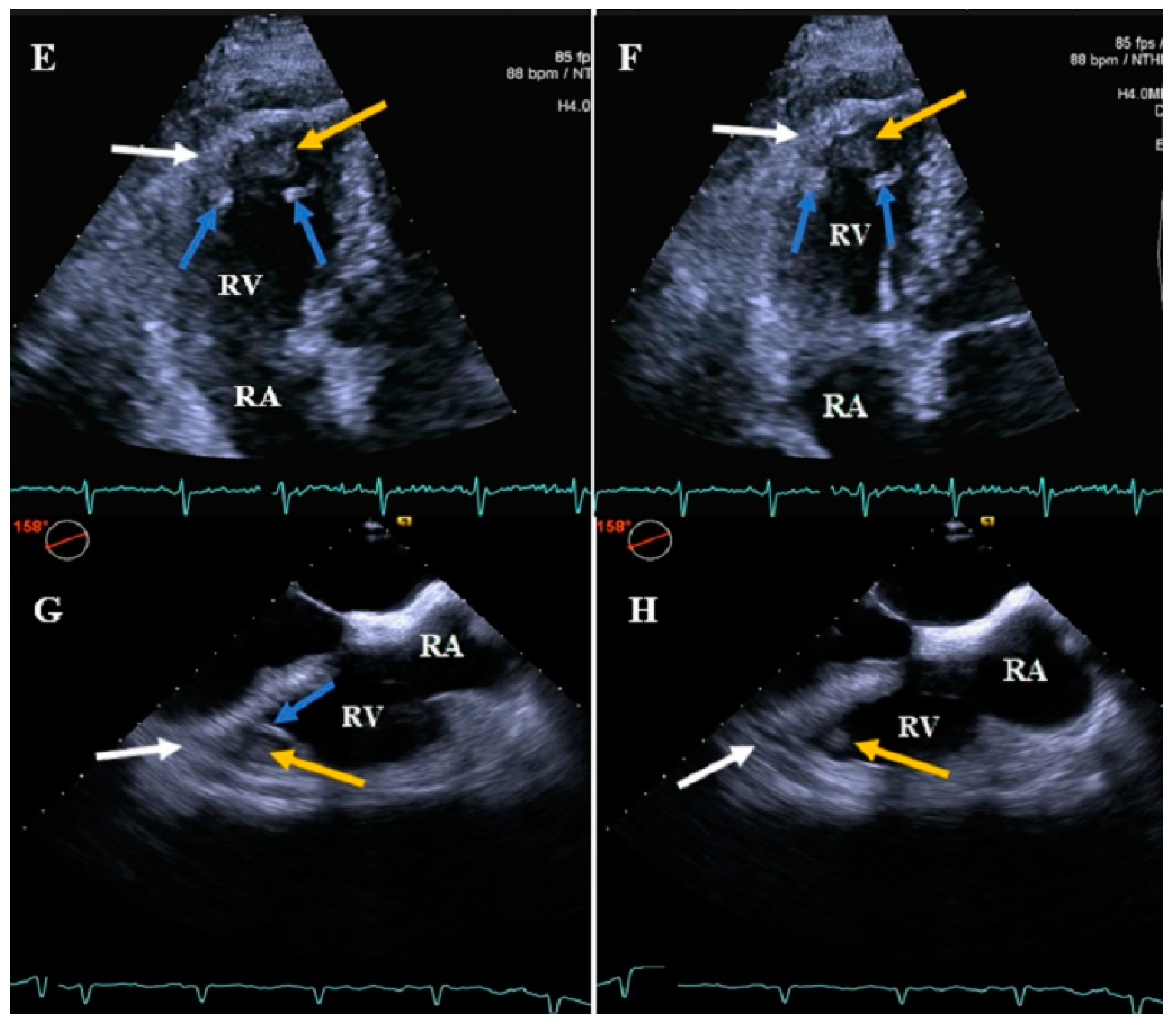
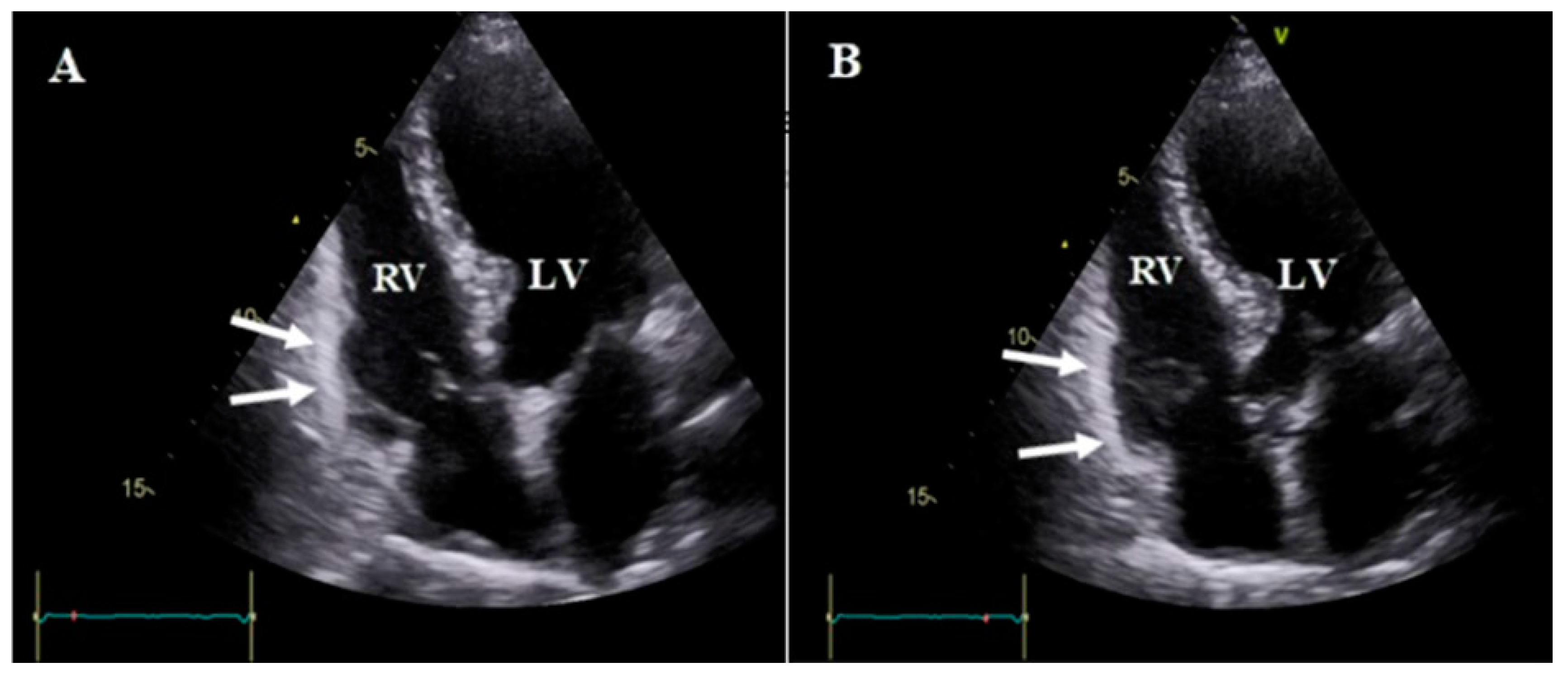


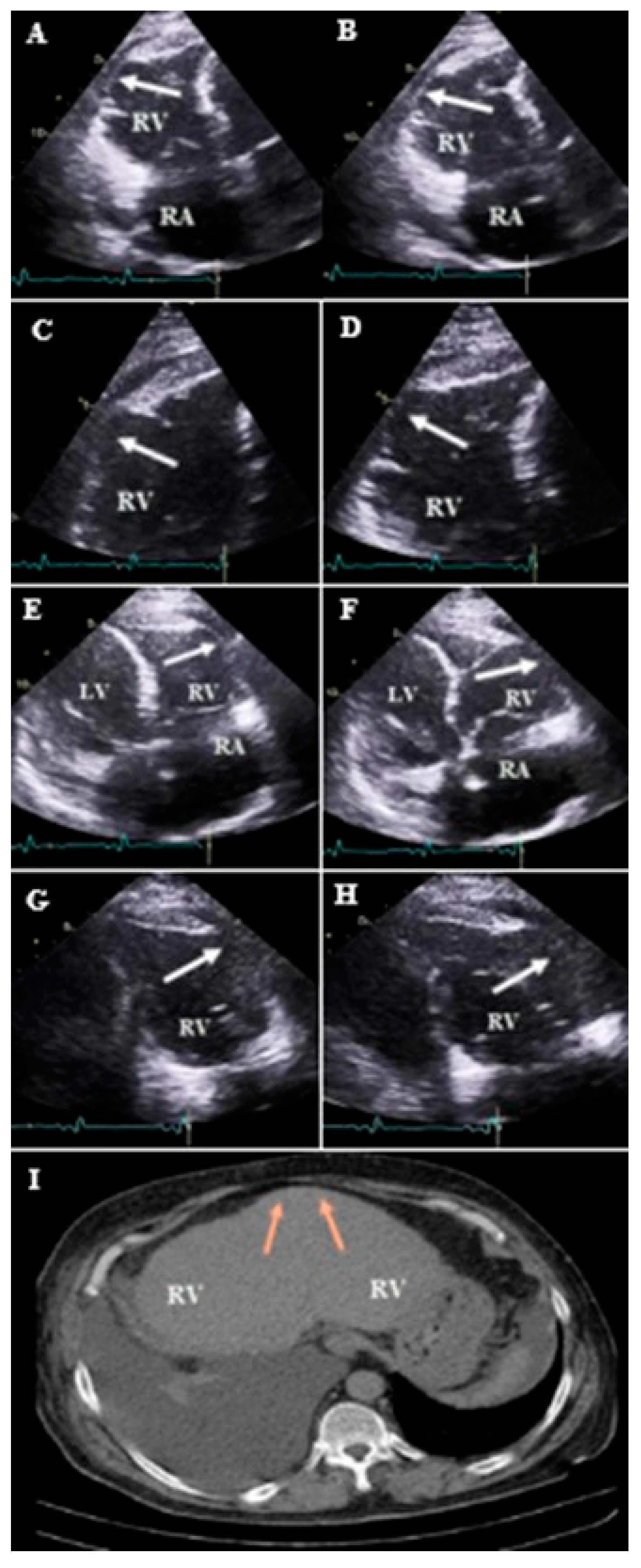
| N. | Sex | Age | Underlying Diseases | Smoker | ECG Result | Vessel Disease | RCA Cut Proximal to RV Branch | Stage of LV Systolic Dysfunction | Lv Aneurysm | LV Clot | Stage of RV Systolic Dysfunction | Anatomical Location of RV Aneurysm in TTE | RV Clot | Other Findings |
|---|---|---|---|---|---|---|---|---|---|---|---|---|---|---|
| 1 | M | 68 | HLP, HTN, CAD, CKD stage II, CABG, PCI | + | OIMI | 3 | + | Moderate | + | - | Severe | apical and apicolateral | - | - |
| 2 | M | 58 | HLP, CAD, CKD stage III, CABG | + | OIMI | 3 | + | Severe | + | + | Severe | distal part of RVOT | - | DHF |
| 3 | F | 82 | HLP, HTN, CAD, T2DM, CKD stage II, PCI | - | OIMI | 3 | + | Severe | - | - | Severe | apicolateral | + | - |
| 4 | M | 62 | CAD, CABG | + | OIMI | 3 | + | Severe | - | - | Severe | mid lateral wall | - | - |
| 5 | F | 74 | HLP, HTN, T2DM, CAD, CKD stage III, CABG, PCI | - | OIMI | 3 | - | Moderate | + | - | Severe | apicolateral | + | DHF |
| 6 | F | 81 | HTN, CAD, CKD stage II, refused to undergo CABG | + | OIMI | 3 | + | Severe | + | + | Severe | basal portion of anterior wall | - | - |
| 7 | M | 69 | HLP, HTN, T2DM, CAD, CKD stage IV, CABG, PCI | + | OIMI | 3 | + | Severe | + | - | Severe | mid portion of lateral wall | - | DHF |
| 8 | F | 66 | HLP, HTN, CAD, CKD stage II, CABG, PCI | - | NS | 3 | + | Severe | + | - | Severe | basal portion of lateral wall | - | - |
| 9 | M | 60 | CAD, CABG last week | + | NS | 3 | + | Mild | - | - | Moderate | apicolateral | - | - |
| 10 | M | 35 | Family history of CAD | + | Acute inferoposterior+RV MI | 3 | + | Mild | - | - | Moderate | apical and apicolateral | + | Received fibrinolytic therapy |
| 11 | M | 69 | Chronic ischemic cardiomyopathy, CABG | + | OIMI | 3 | + | Severe | + apical | + | Severe | distal part of RVOT | - | Candidate for ICD |
| 12 | M | 32 | - | + | Acute inferoposterior and RV MI | 1 | Severe proximal RCA thrombosis | Mild | - | - | Severe, akinesia+ mild RV dilation | basal portion of lateral wall | - | Acute chest pain |
| 13 | F | 76 | HTN, CAD, CKD stage II, CABG, PCI | + | Old inferior STEMI | 3 | + | Moderate, akinetic inferior walls | - | - | Moderate, mild RV dilation | mid-anterior portion | - | stable angina |
| 14 | M | 74 | HLP, HTN, CAD, CKD stage II, CABG, PCI | + | OIMI | 3 | + | Moderate | + apical | - | Severe | basal portion of inferior wall | - | angina pectoris for months |
| 15 | M | 79 | HTN, T2DM, CAD, CKD stage IV, PCI twice | + | NS | 2 | + | Severe | + | + apical | Severe | basal lateral wall | - | - |
| 16 | M | 60 | CAD, CABG, PCI twice | + | OIMI | 2 | + cut mid RCA | Moderate | + apical | - | moderate | apical and apicolateral | - | - |
| 17 | F | 76 | CAD, PCI | - | Acute inferior MI | 3 | +, conus branch stenosis plus cut mid RCA | Mild | - | - | Mild | distal part of RVOT plus mid anterior wall | - | Planned for staged CABG |
| 18 | M | 65 | CAD, PCI twice, HTN, T2DM, HLP | + | OIMI | 3 | + | Severe | - | - | Severe | mid RV free wall | - | DHF |
Disclaimer/Publisher’s Note: The statements, opinions and data contained in all publications are solely those of the individual author(s) and contributor(s) and not of MDPI and/or the editor(s). MDPI and/or the editor(s) disclaim responsibility for any injury to people or property resulting from any ideas, methods, instructions or products referred to in the content. |
© 2023 by the authors. Licensee MDPI, Basel, Switzerland. This article is an open access article distributed under the terms and conditions of the Creative Commons Attribution (CC BY) license (https://creativecommons.org/licenses/by/4.0/).
Share and Cite
Sharifkazemi, M.; Rahnamun, Z.; Jumana, Z.; Khosropanah, S. Two-Dimensional Transthoracic Echocardiography-Based Diagnosis of Right Ventricular Aneurysm: A Neglected Issue in Patients with Coronary Artery Disease: Case Series and Literature Review. Diagnostics 2023, 13, 2194. https://doi.org/10.3390/diagnostics13132194
Sharifkazemi M, Rahnamun Z, Jumana Z, Khosropanah S. Two-Dimensional Transthoracic Echocardiography-Based Diagnosis of Right Ventricular Aneurysm: A Neglected Issue in Patients with Coronary Artery Disease: Case Series and Literature Review. Diagnostics. 2023; 13(13):2194. https://doi.org/10.3390/diagnostics13132194
Chicago/Turabian StyleSharifkazemi, Mohammadbagher, Zahra Rahnamun, Zehra Jumana, and Shahdad Khosropanah. 2023. "Two-Dimensional Transthoracic Echocardiography-Based Diagnosis of Right Ventricular Aneurysm: A Neglected Issue in Patients with Coronary Artery Disease: Case Series and Literature Review" Diagnostics 13, no. 13: 2194. https://doi.org/10.3390/diagnostics13132194
APA StyleSharifkazemi, M., Rahnamun, Z., Jumana, Z., & Khosropanah, S. (2023). Two-Dimensional Transthoracic Echocardiography-Based Diagnosis of Right Ventricular Aneurysm: A Neglected Issue in Patients with Coronary Artery Disease: Case Series and Literature Review. Diagnostics, 13(13), 2194. https://doi.org/10.3390/diagnostics13132194





